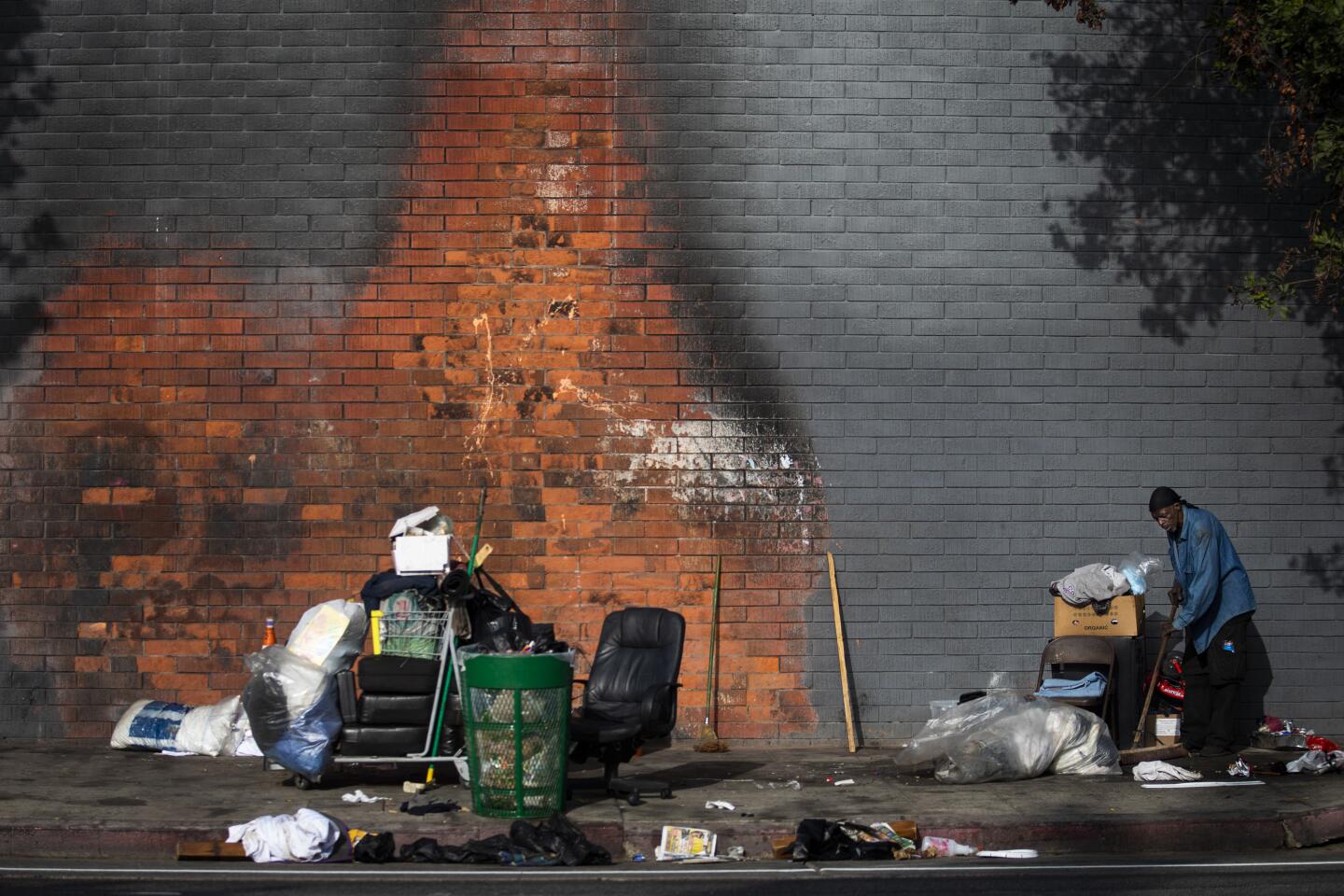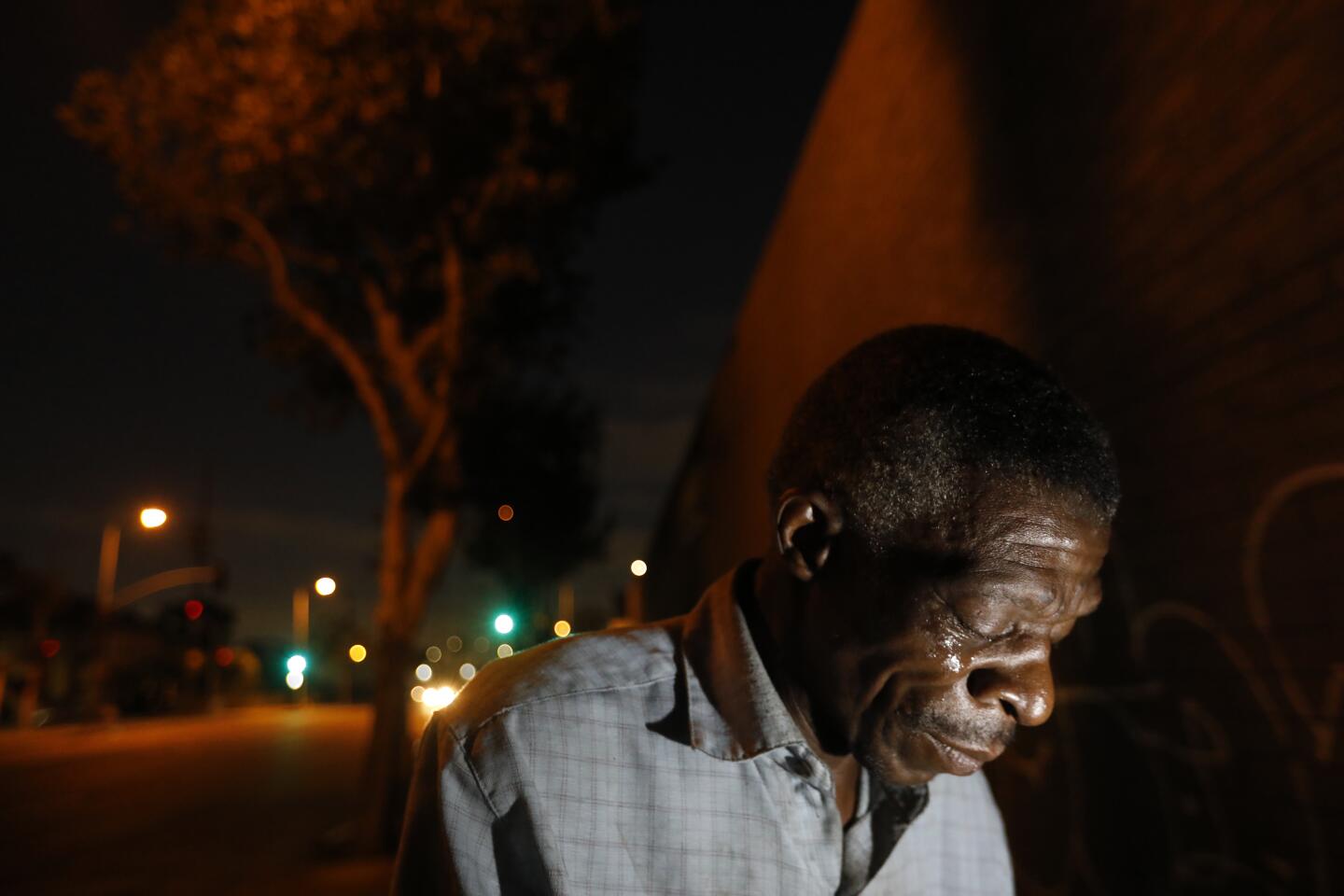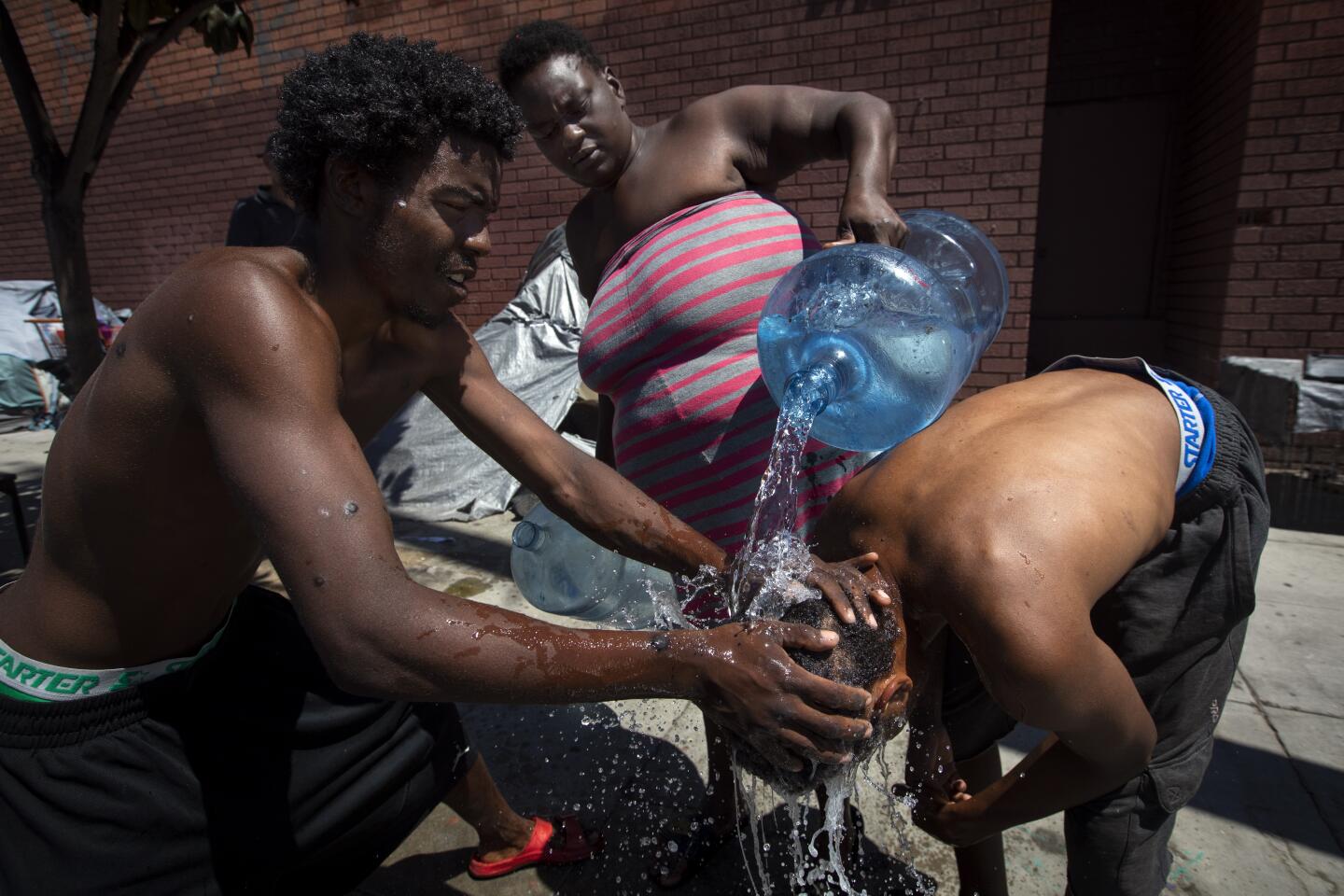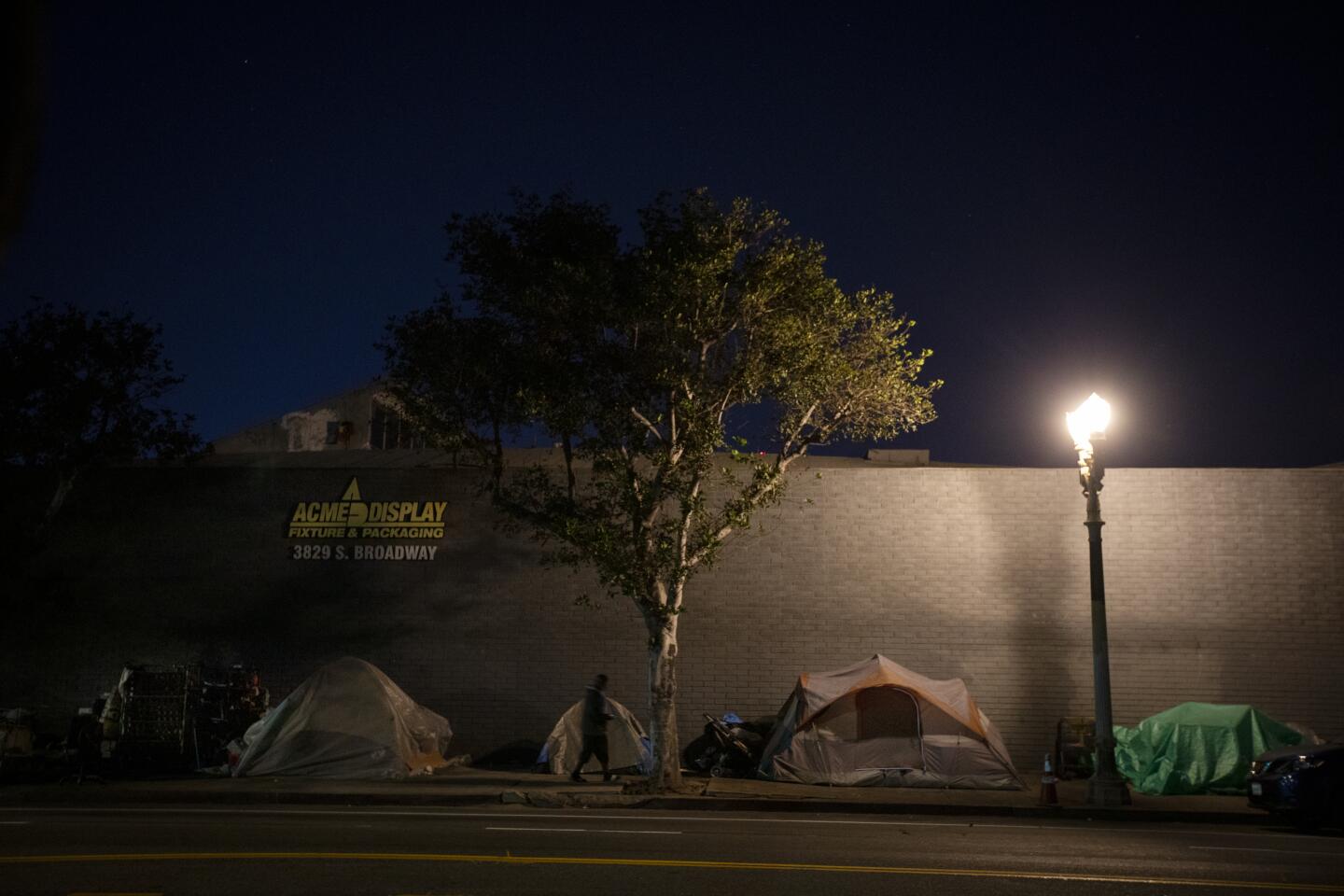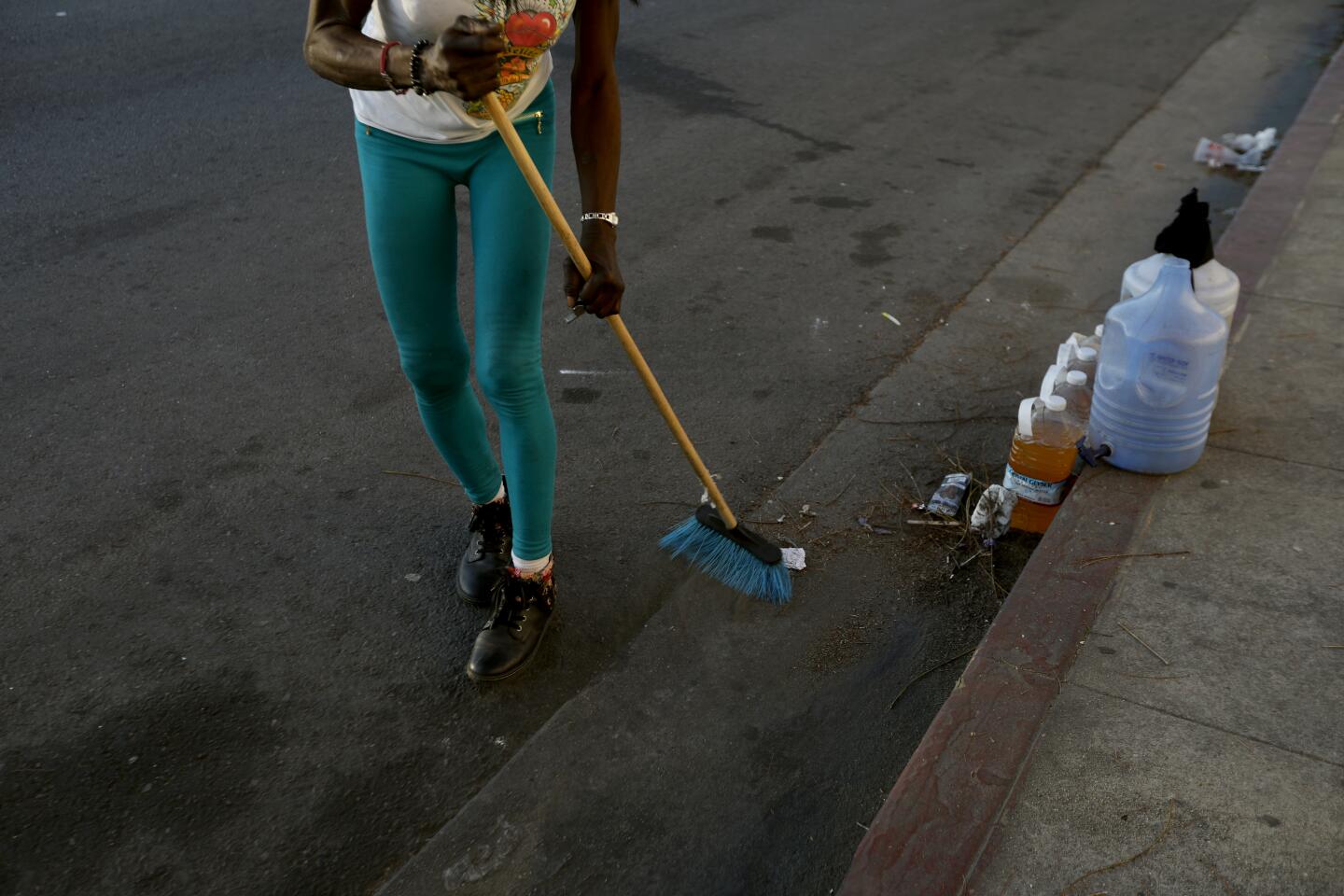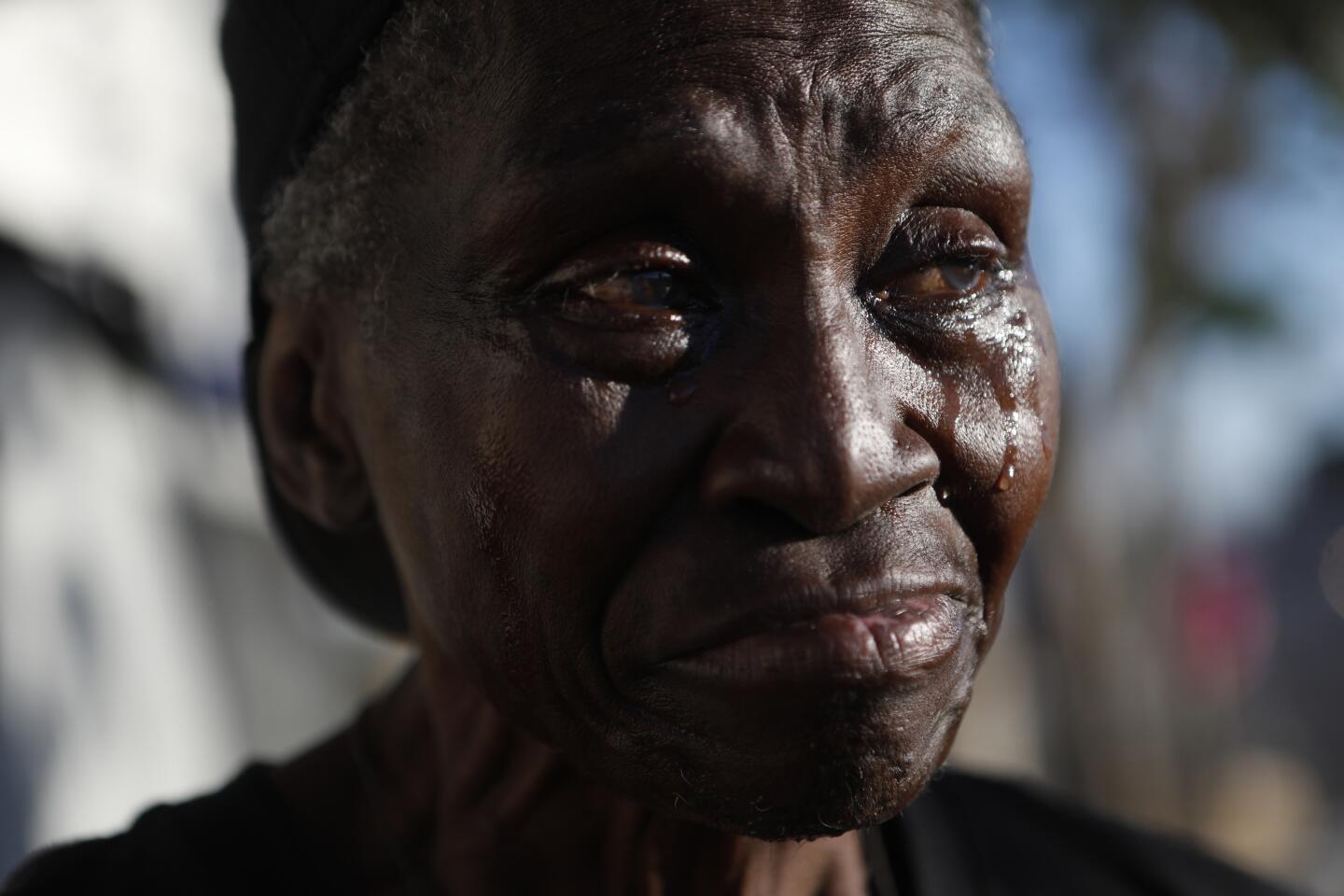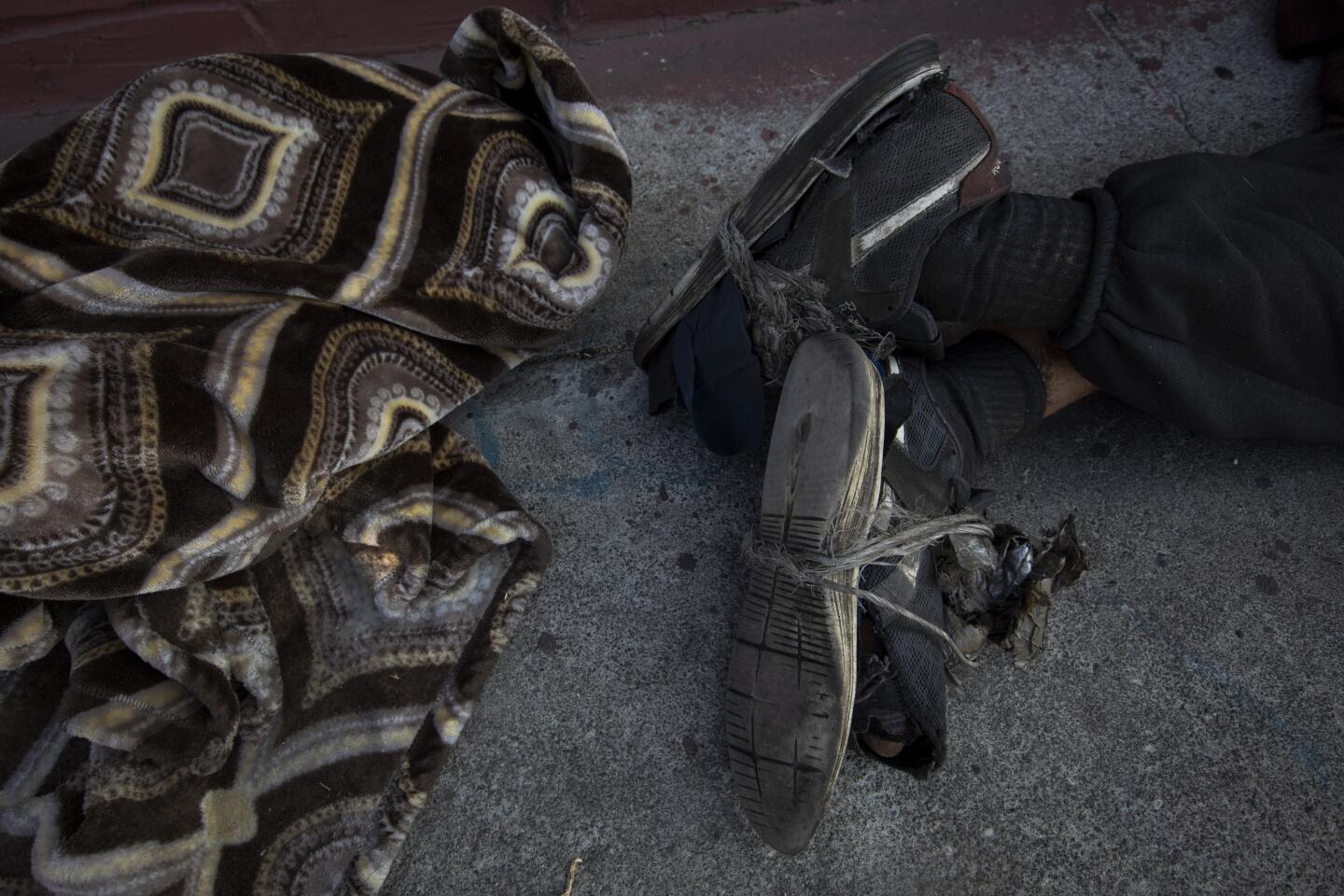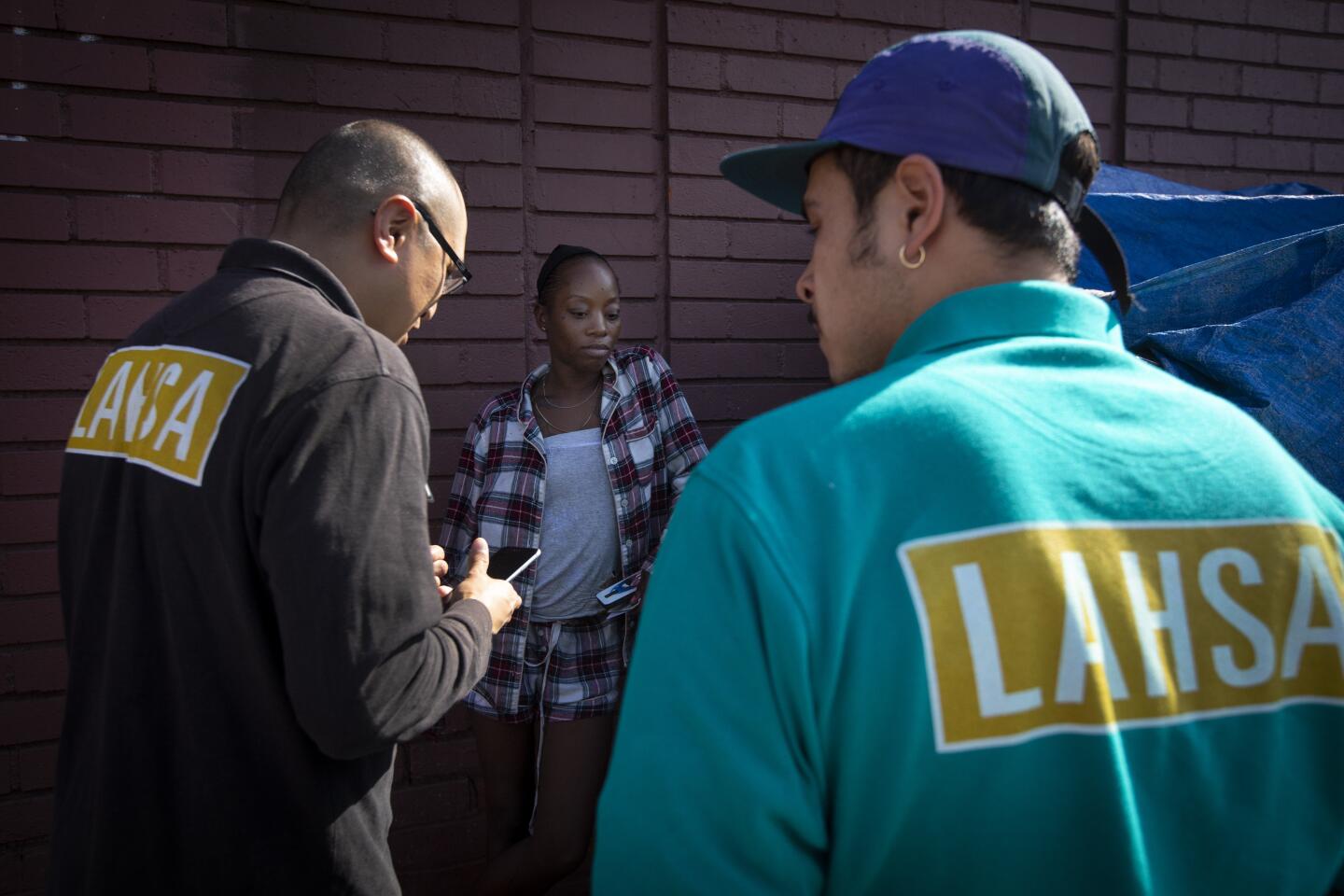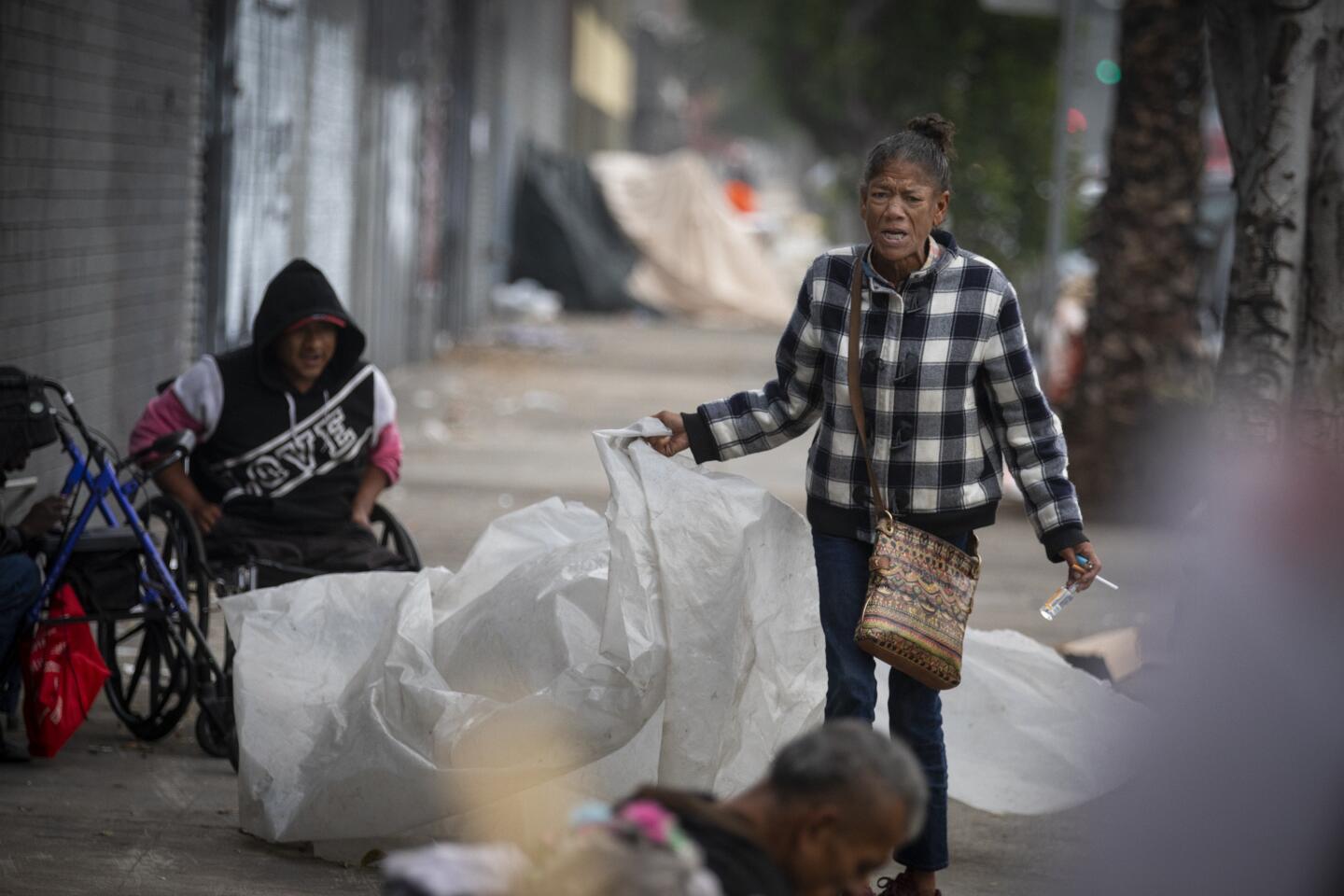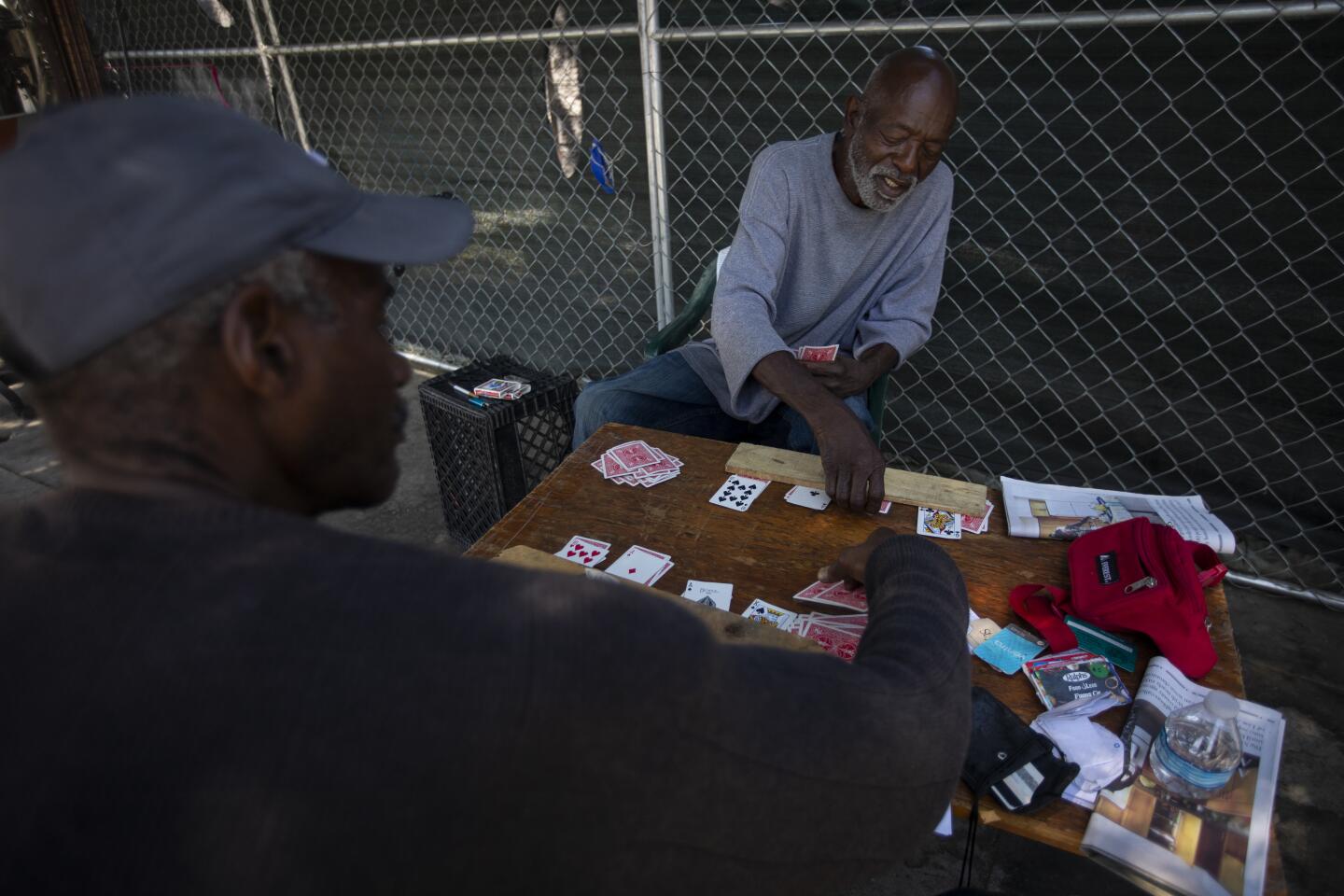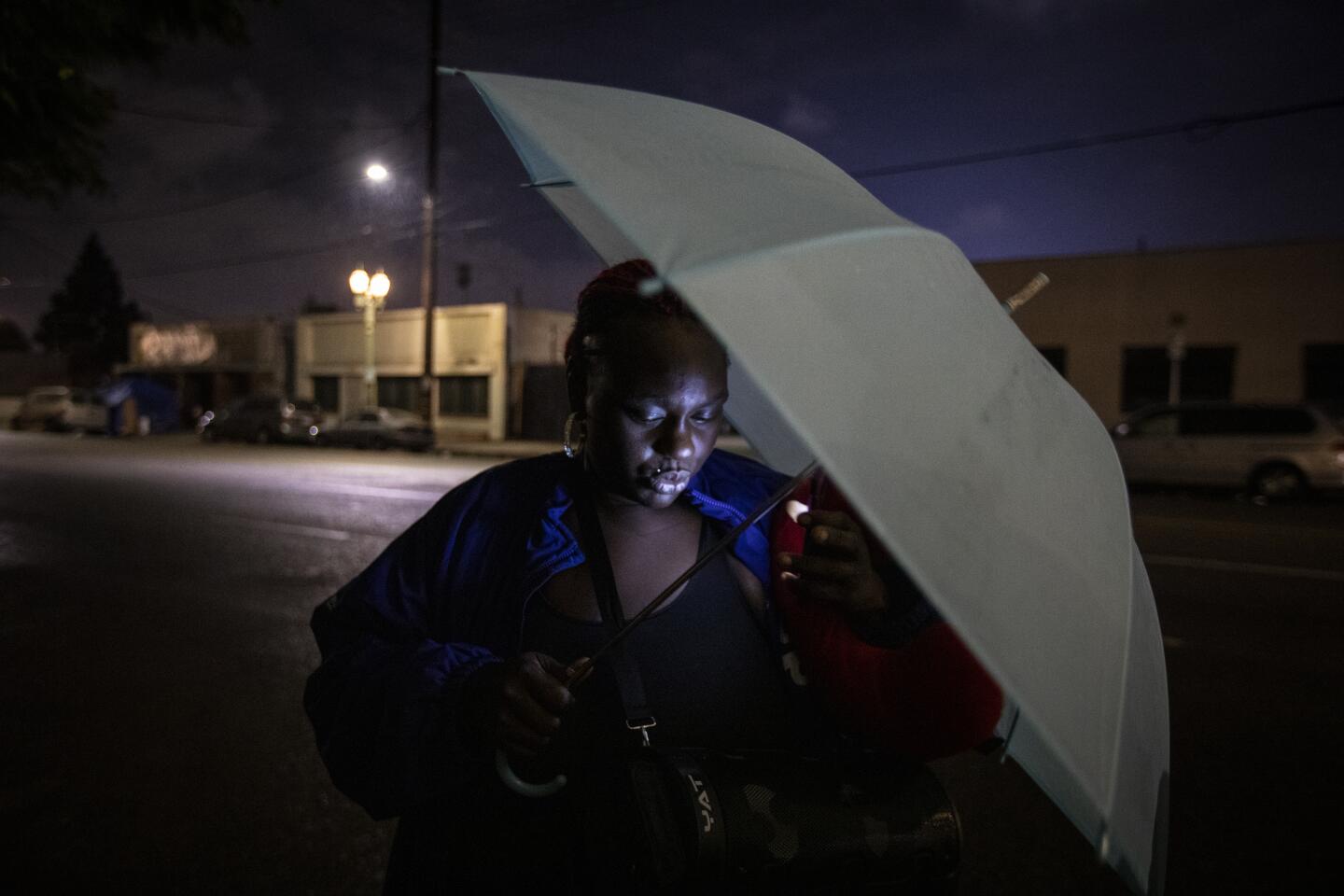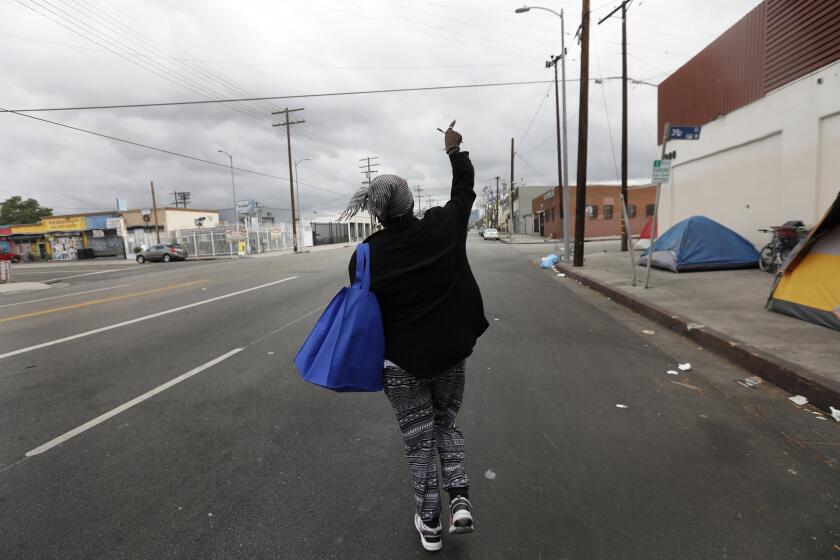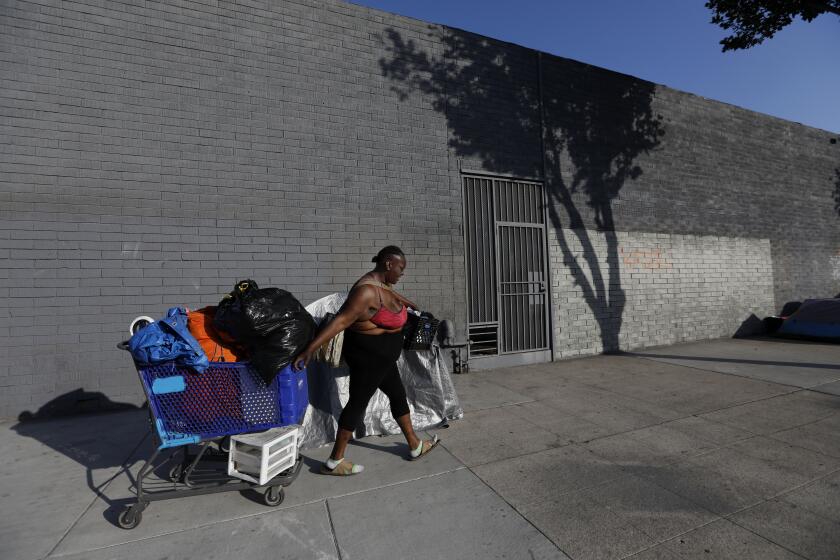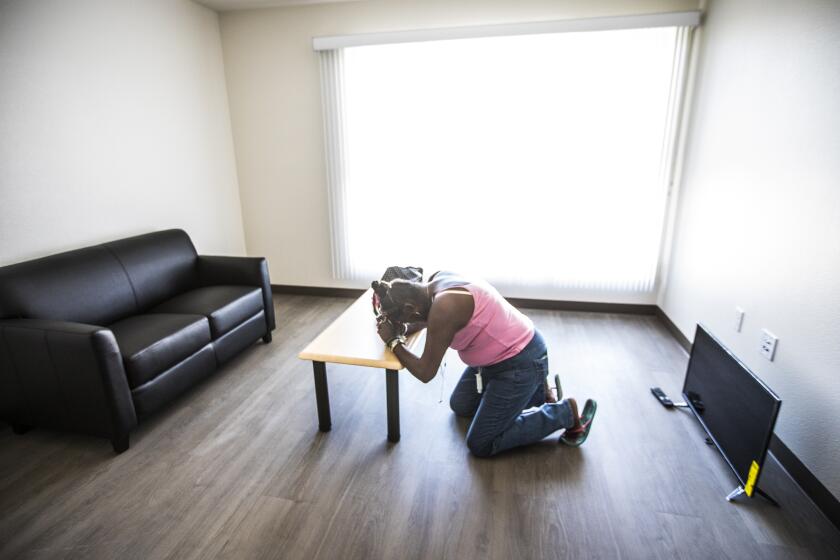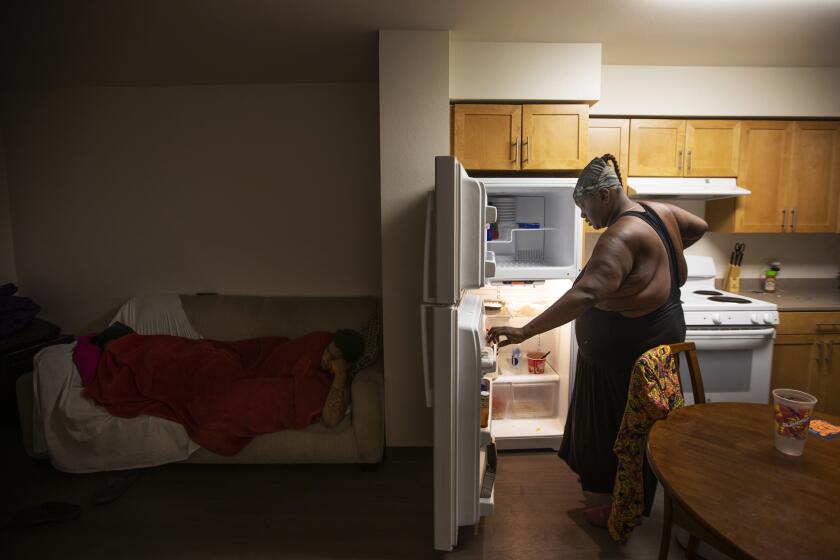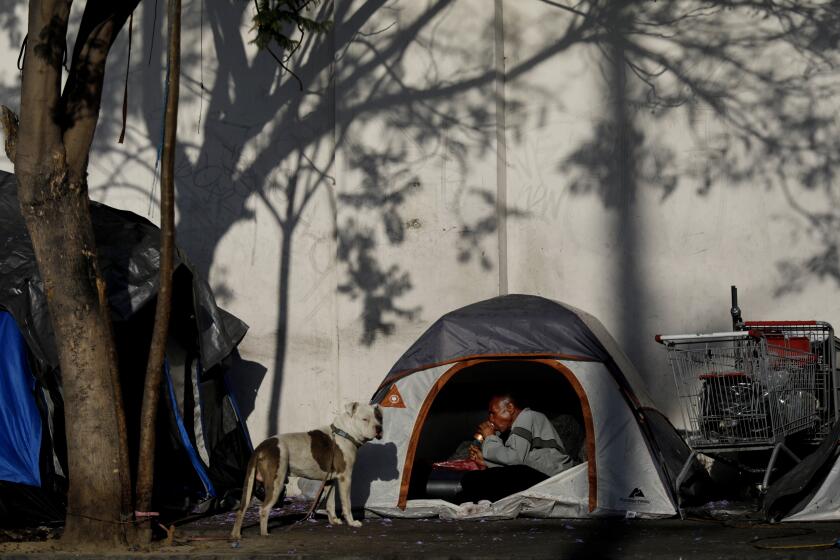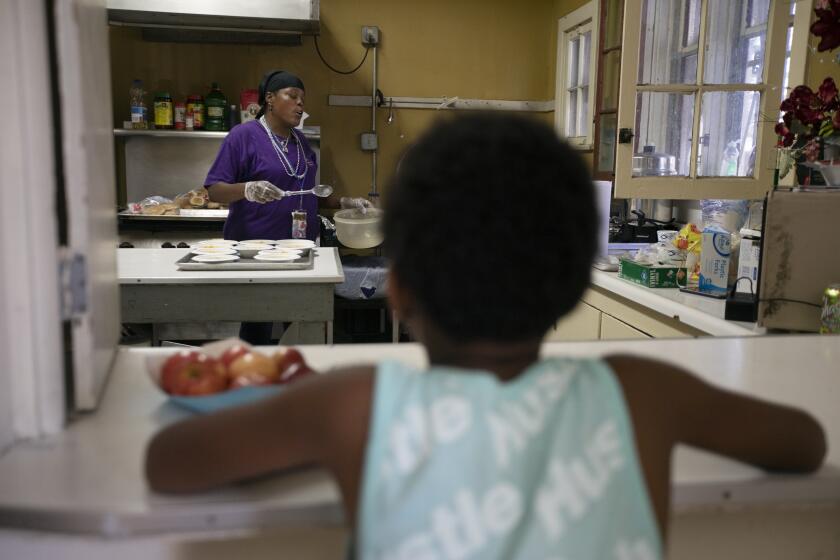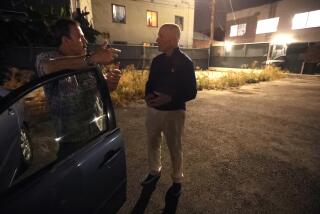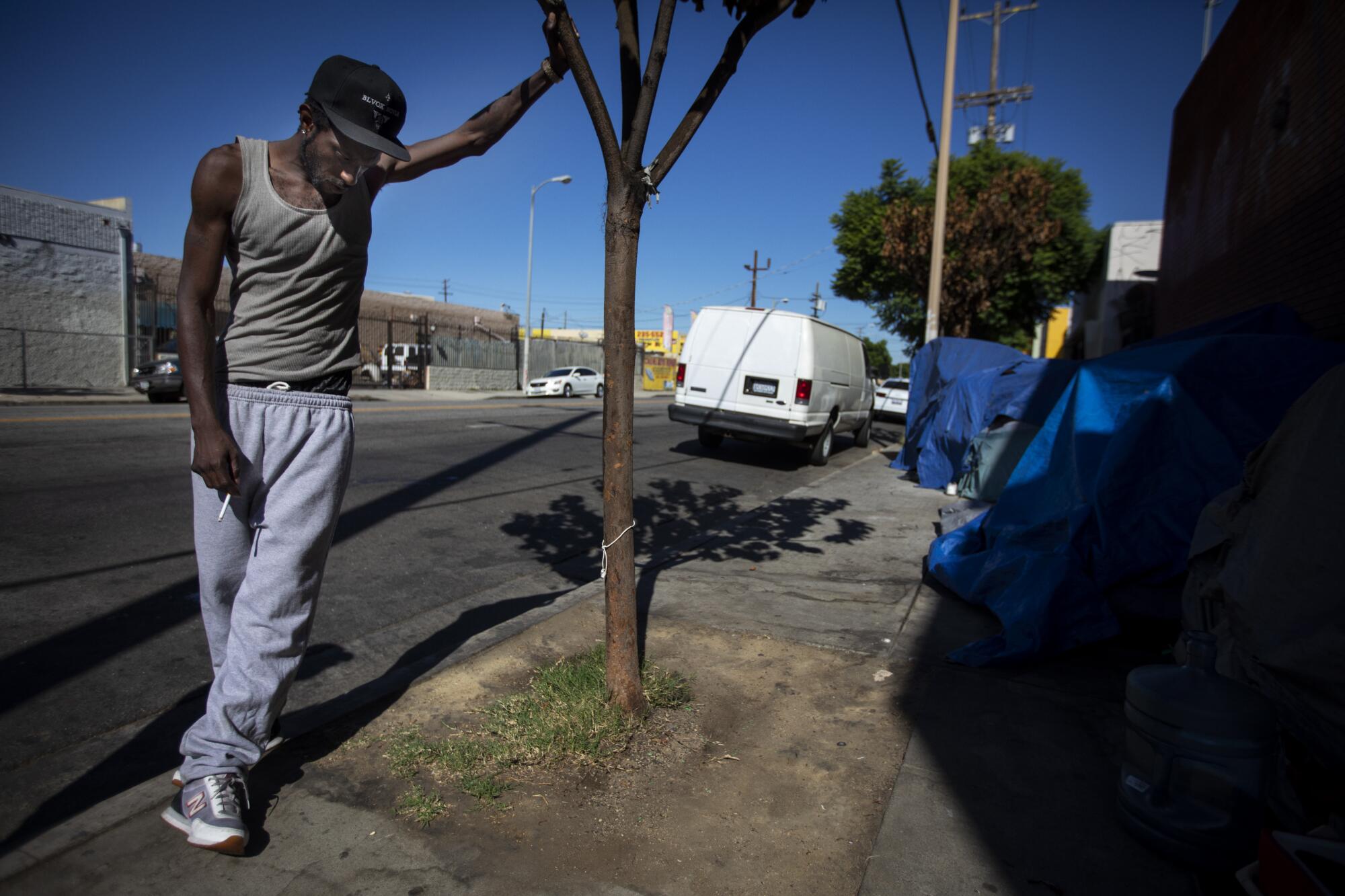
Eleven months ago, Leneace Pope and Dion Hines might have thought they had won the lottery. Instead of cash, their prizes were new apartments with air conditioning and heating, dishwashers and bathtubs and, after years of homelessness, hot water at the turn of a faucet.
Today, the two friends are back on the street, living side by side â Leneace in a tent and Dion under a tarp â against the brick facade of a building once occupied by a zipper maker on Main Street, south of the shiny high-rises in downtown Los Angeles.
Traffic is loud, strangers urinate in a nearby doorway, and there are rats: They run in the gutters at night. They scour garbage cans for tamale husks and banana peels, half-eaten noodles and rice. One chews on the crusted lid of an empty TapatĂo bottle.
The battle against rats is endless. Like the streets, they often win.
âIâm tired of being out here,â Leneace says. She prefers a shortened version of her name: Niecy. She is 34 and has been homeless, off and on, since 2004.
Neither Niecy nor Dion had imagined they would be homeless again. âI was loving my apartment,â Dion says. âI could lock my doors and go in and out and not worry.â
They lasted six months before returning to this neighborhood.
Los Angeles is spending billions of dollars over 10 years in a historic bid to move people from the streets into housing and to ease a worsening homeless crisis. The campaign, less than 3 years old, has changed lives as encampments are cleared and apartments occupied.
But there are those who cannot make it. They are a small percentage who demonstrate just how elusive a solution can be.
Niecy, Dion and their neighbors were lucky to be fast-tracked into housing last year through a one-time program known as Encampment to Home. Moved from these sidewalks, they settled into an apartment complex off El Segundo Boulevard and the 110 Freeway.
Getting off the streets was relatively easy, a matter of following bureaucratic protocols. The greater challenge, once they were inside, was to abide by managementâs rules and regulations.
Niecy and Dion tried to adapt. They had case managers who provided counseling, but there were incidents: threatening behavior, a fight. It was as if the streets had followed them into their homes.
Once again, the streets had won.
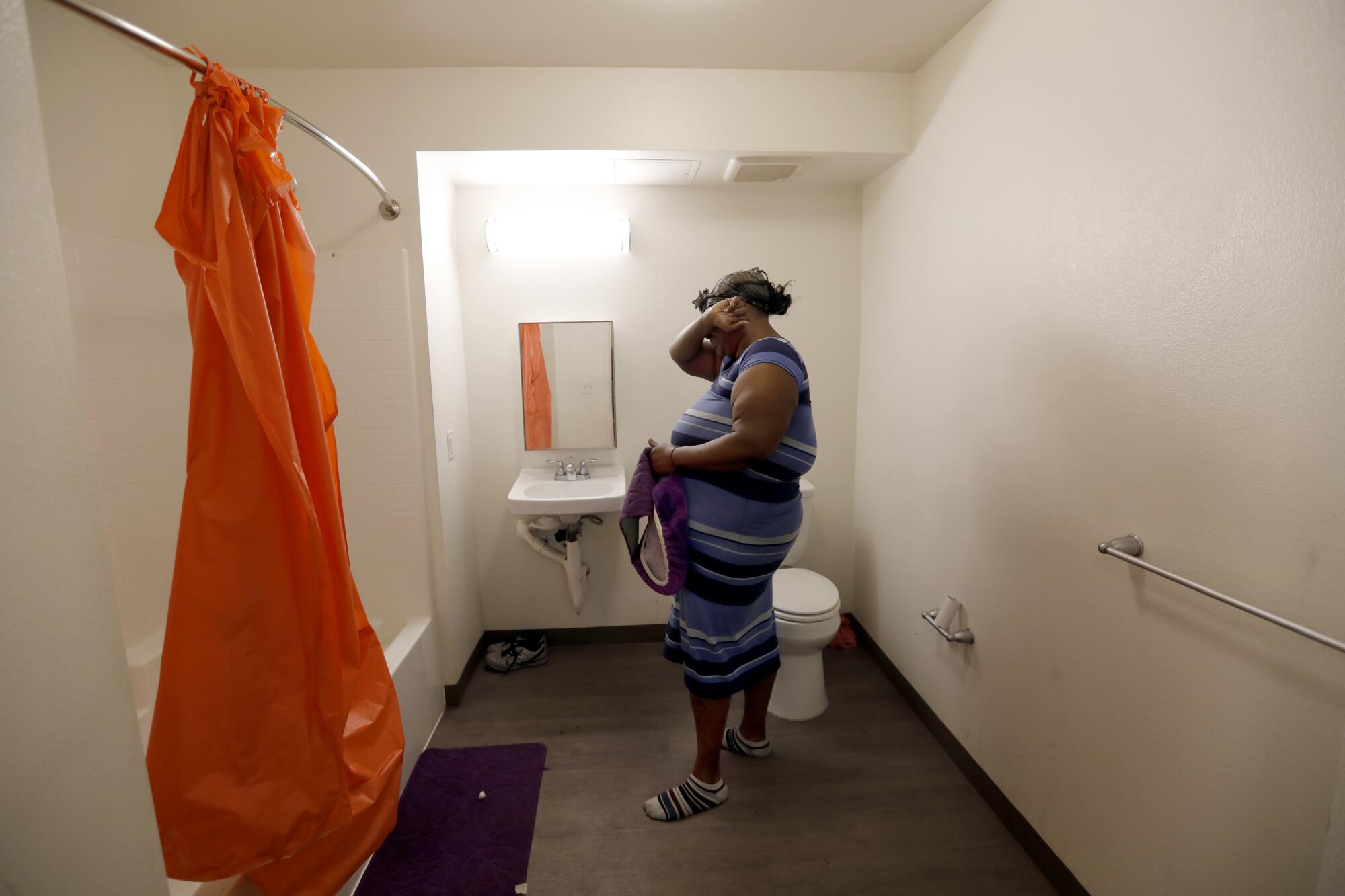
Rather than be evicted â a mark on their records â Niecy and Dion relinquished their units. Now they are starting over. Their experience shows that housing alone will not solve this crisis for everyone. Living with rules and regulations in a close community can be overwhelming.
Outreach workers are continuing to help Niecy and Dion. With their documentation still in order, they should be easy to house, said Ericka Battaglia, a program manager.
But that was three months ago.
::
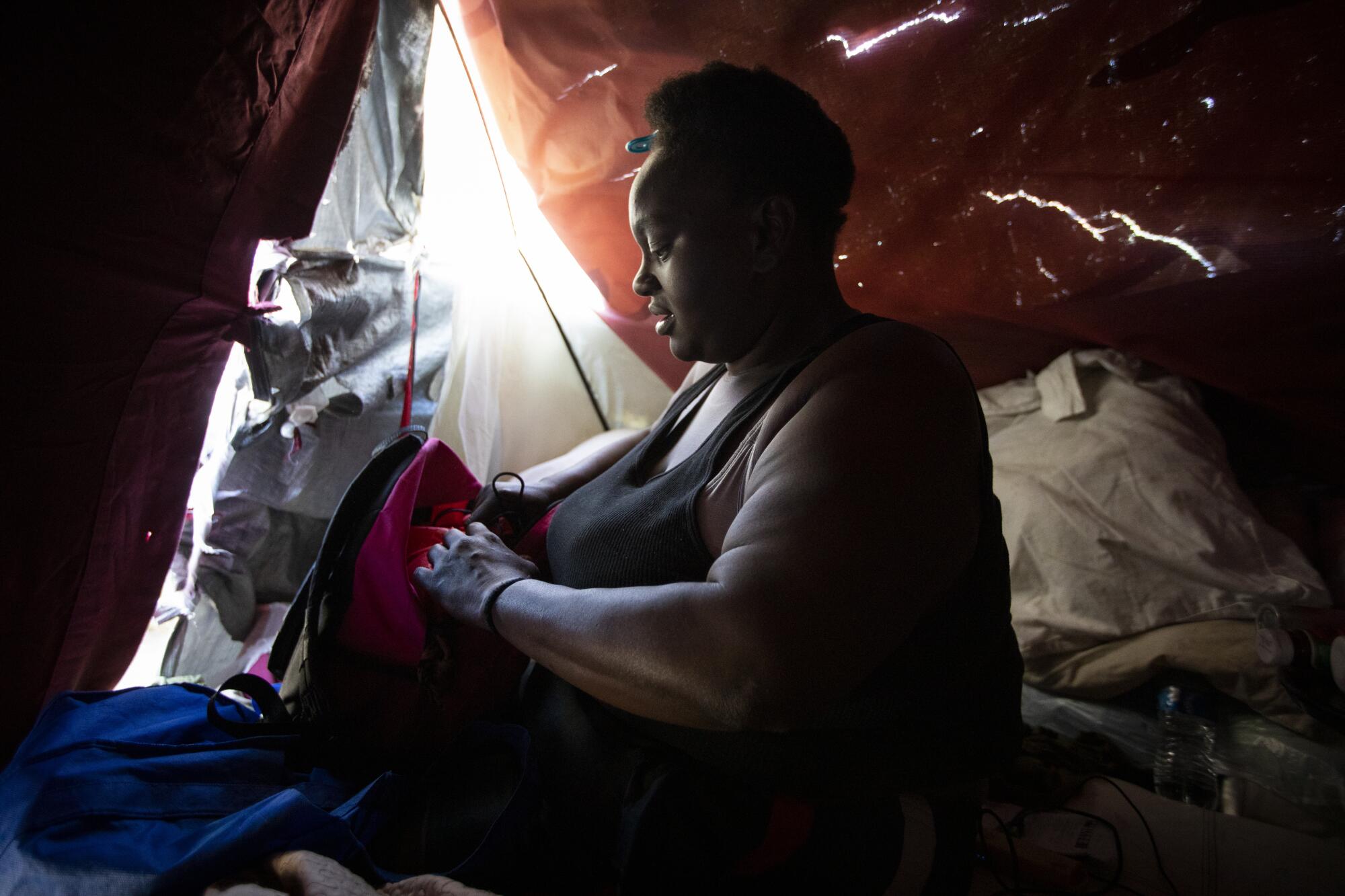
As neglected as these blocks in South Los Angeles might be, thereâs little wonder why Niecy and Dion returned.
Here they can make a home for themselves on their own terms. They can find companionship, survive and feel their existence has meaning in a way it never did in the apartments.
On the street, wounds of the past â loneliness, anger, sadness, hurt or pain â are assuaged by familiarity, easier codes of conduct, isolation and, if need be, perhaps drugs.
Sanitation crews still sweep through. Businesses still dump trash on the already messy sidewalks. The unlicensed pot shop remains open, and parents take their childrenâs hands as they walk to and from a charter school.
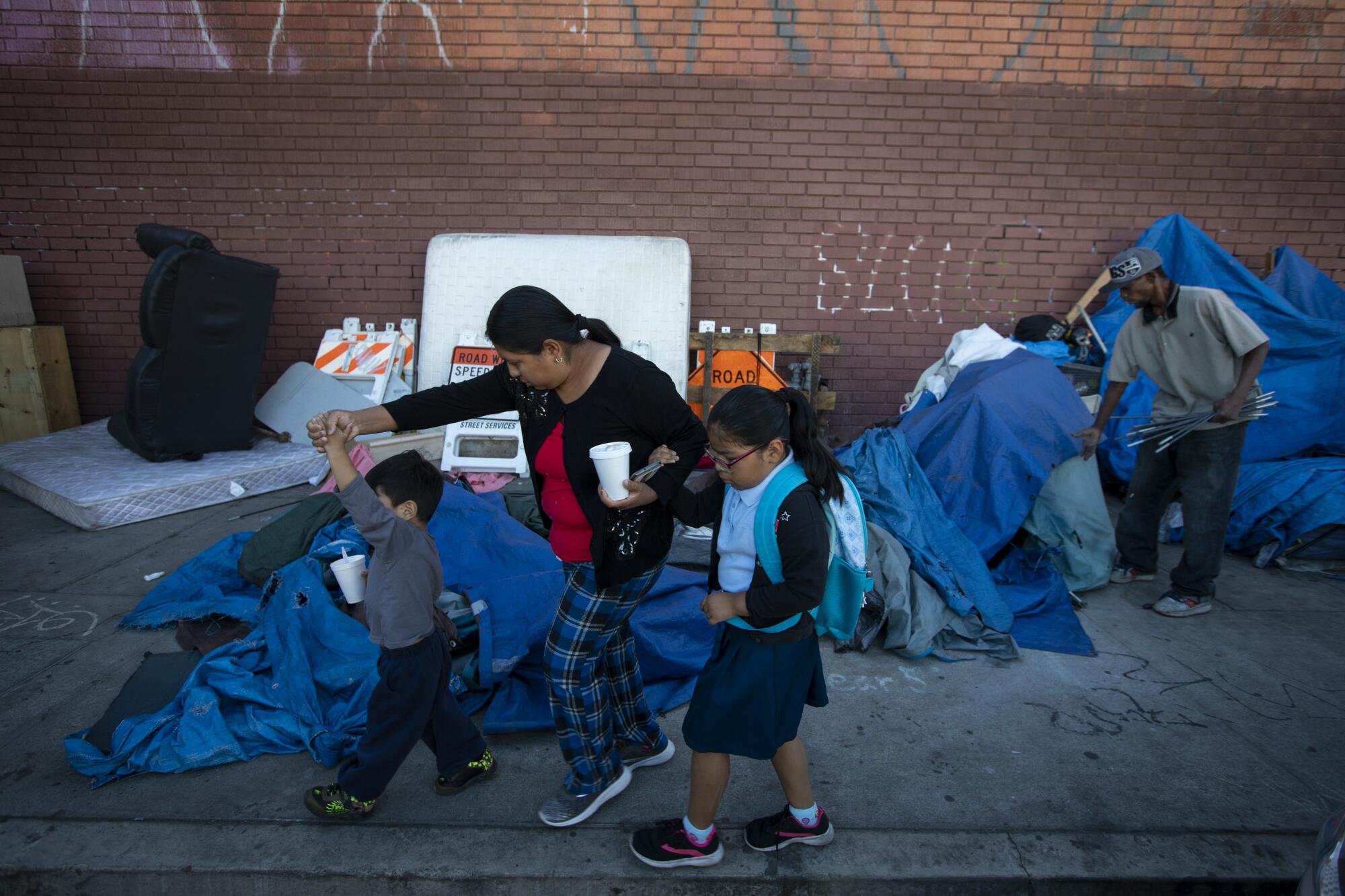
On Broadway Place, Alan Ishii still draws the lock and chain through his driveway gate at 5:30 a.m., ready to start up the mills and lathes in his shop. But he is more wary these days. Last December, he was robbed at gunpoint by an intruder, and at 66, he wonders how much longer he can hold out.
He doesnât have much to do with Niecy and Dion, but he misses Big Mama and Horace, who once lived in tents across the street and helped keep order.
âThey never asked me for anything besides friendship,â he says. Heâs happy they have their apartments and seem to be adjusting.
For months after the Encampment to Home program, the sidewalk along Broadway Place had stayed empty. Then, on June 5, a few people moved over from a block away and set up camp under twin jacaranda trees.
Ishii doesnât feel as safe with them. He fears that meth has taken hold.
He wishes the new residents would keep the encampment clean and drama-free. But theyâre now breeding dogs â for protection and profit â and recently one got out and bit someone. Police arrived with guns and tasers.
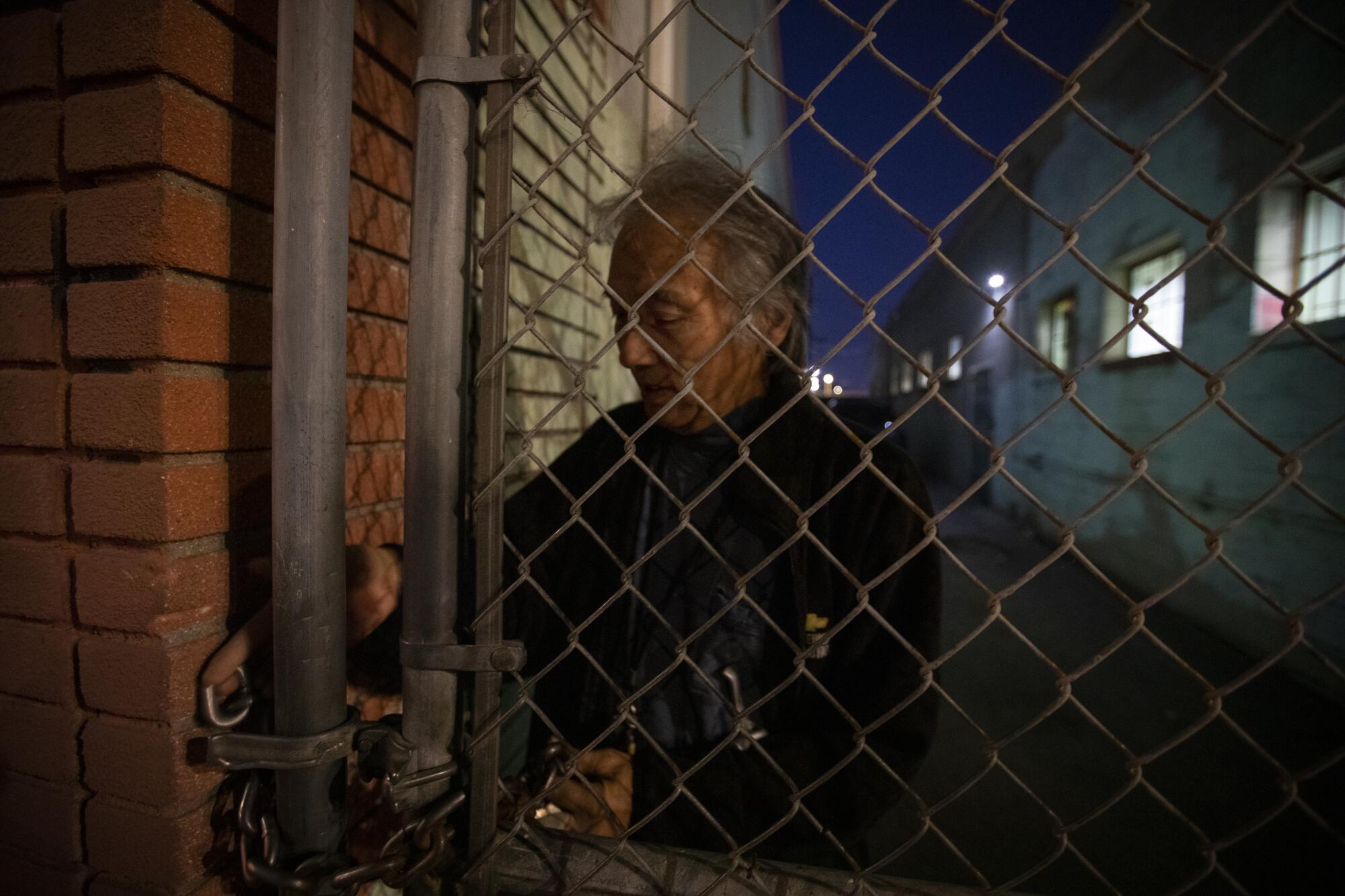
âLos,â 39, has put himself in charge but doesnât want to give his name. He said he once lived in Pico Rivera and spent time in the Rio Hondo wash before coming downtown.
His tent is spacious enough for him and the woman he lives with. He keeps a zip line out front for his pit bull, Nala, and has spray-painted the sidewalk with warnings for pedestrians.
âBeware,â the signs say.
::
The rhythms of the neighborhood â the dealing and hustling, the hope and despair â are insistent.
The corner restaurant, Golazo, has a new paint job, with an image of the Virgin of Guadalupe gazing upon Martin Luther King Boulevard.
Across from a menâs shelter, tents line the sidewalk in front of a construction site where workers are completing a three-story storage facility.
A clothing designer, Naked Zebra, has renovated a derelict building on whose sidewalk Dion once pitched his tent.
Some regulars are still around, and everyone, it seems, is waiting for an outreach worker, or wondering why getting housed takes so long.
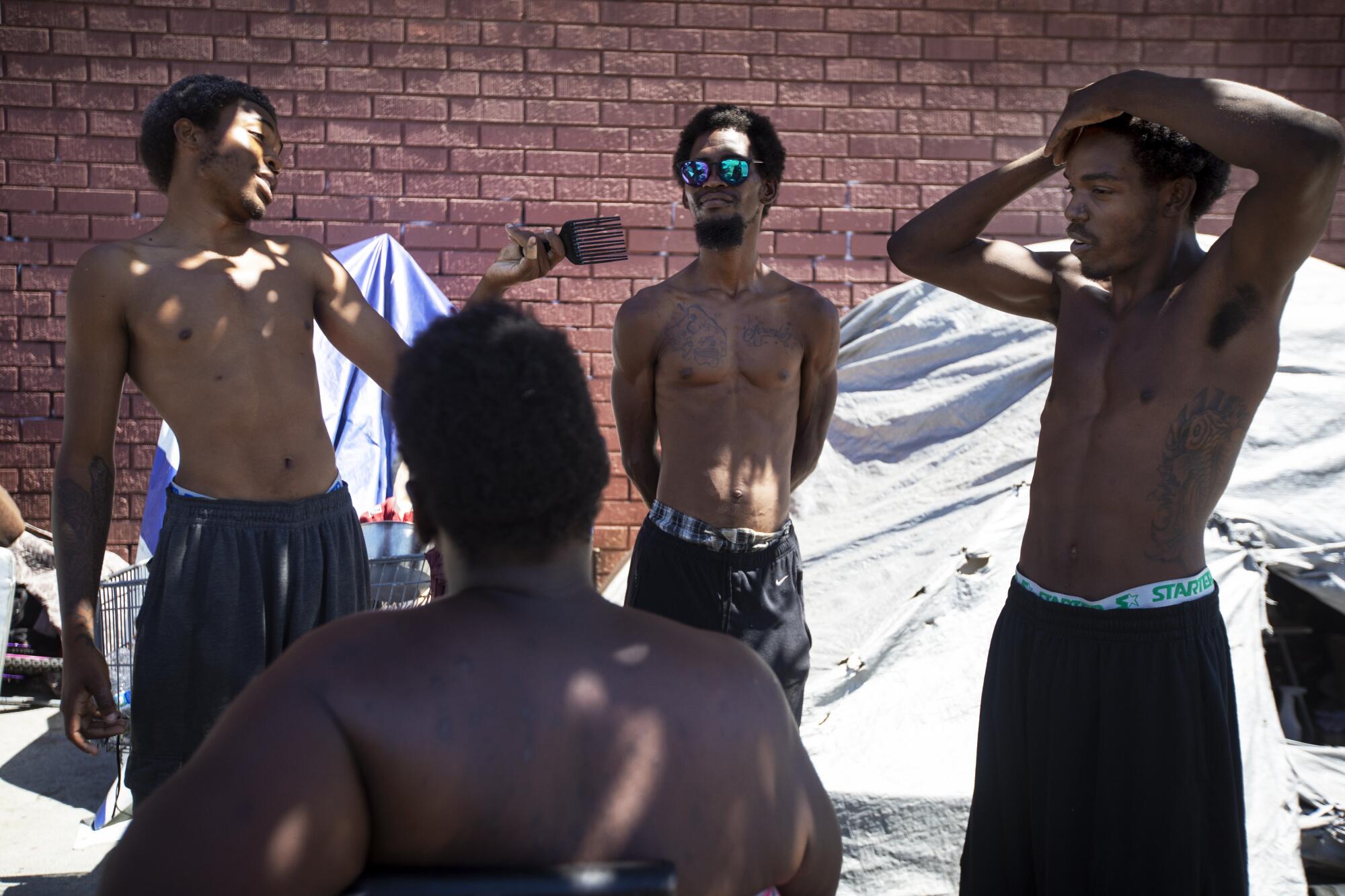
Jermaine Autry, Niecyâs former boyfriend, lives near Niecy, his encampment no more than a trash heap.
Michael Walker â Pops, to some â is still giving men from the shelter a place to congregate during the day. Jamerson Leon, who lives with his wife in a small apartment on 39th Street, stands as a security guard for the evening shift of garment workers walking to their cars.
Floyd Williams and Arleta Brown, whom everyone calls Liquor Store, are fighting. One brawl, which she had provoked with insults and spitting, left her lying in the gutter.
Robert Taylor is still undeterred, his good humor making his life, amid a ragged collection of tarps and shopping carts, all the sadder.
Outreach workers go on their rounds, aware of everyoneâs needs, yet reminded every day of a system that is overwhelmed.
âYou might get a couple off the streets, but theyâre replaced by multiples,â says Odessa Henderson, an outreach nurse with a homeless agency. âWeâve gotten one or two off the street and into the new bridge shelter at St. Andrews, but then four or five take their place out here.â
Henderson is visiting Cynthia Finex, who lives on South Broadway.
Finex, 58, sits outside her tent in the shade of a sidewalk fig tree, playing Candy Maker on her phone. Speaking with a slur, the result of a stroke, she says that her partner, Herman Nelson, is at a doctorâs appointment. A few weeks back, necrotic tissue from diabetes had forced the partial amputation of a toe on his right foot.
The couple hope to leave Los Angeles soon. Theyâve had enough.
For now, though, South Broadway is home, and for most sidewalk dwellers, that wonât be changing anytime soon. The city and county donât have apartments for them.
Pushed out by families, rising rents, job losses, addiction and poor health, they too carry the streets within them, and, if anything, they are comforted to know that they cannot fall any lower. They have nothing left to lose.
The streets have won.
All else is a risk, as Niecy and Dion know.
::
Niecy holds only herself responsible for what happened in her apartment. Dion wishes he had gotten more support from his counselor.
Given a second chance, they would do things differently. They would keep more to themselves and shut their doors to friends who needed a place to crash.
Under Encampment to Home, Niecy and Dion had been approved for housing subsidies in a building occupied predominantly by people like themselves, eligible for on-site supported services and rental assistance.
But having lost those apartments, they are now among the thousands sleeping either on the streets or in shelters, motels or interim housing sites.
Niecy and Dion hold a slight advantage, though. They qualify for another program administered by the Housing Authority of the city of Los Angeles, which serves the chronically homeless.
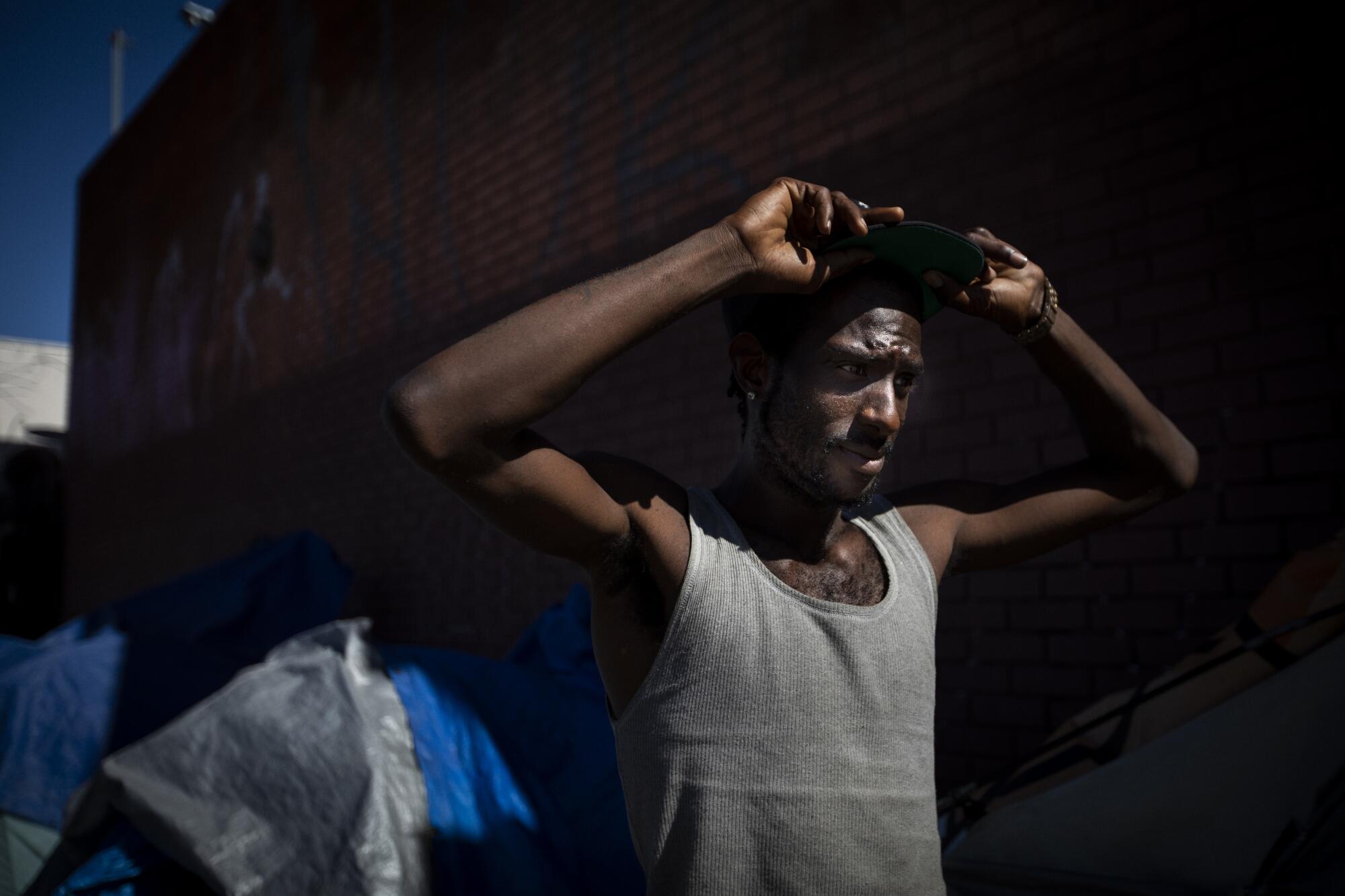
Under its guidelines, they will receive federal Section 8 vouchers for low-income people. Then they can look for apartments that accept rental subsidies.
âPeople who get a voucher have to work hard to be successful,â says Carlos Van Natter, a Section 8 administrator for the Housing Authority. âOnly one out of two who gets a voucher actually finds a place.â
Throughout the process, the homeless agencies are required to provide supportive services to meet their obligations with the Housing Authority. As a result, workers keep up a steady refrain, encouraging clients to show up for their outreach appointments.
The system is designed to get people â especially those with mental or physical health issues or substance abuse issues â off the streets and provide them with whatever support they need to stay housed.
Everyone has to be committed to the process, but sometimes life gets in the way.
Not long after losing his apartment, Dion was offered a place in Pasadena, but he turned it down. It was too far away from his 5-year-old daughter, who was living with her mother.
More recently, he had a chance for a bed in a shelter that was about to open, but he turned that down too. JeâKwese Ross, his girlfriend, wouldnât have been able to join him.
::
For her part, Niecy is trying.
Munching on Starbursts, she sits with her counselor, Julie Tejada, in a windowless office off Broadway and Slauson for a mental health session.
Tejada keeps the lighting dim and homey. A throw pillow on the sofa reads âDream & Believe,â and a silk plant â green leaves, pink flowers â sits on a table with Sweet Swirl lollipops and a container of condoms.
The streets are far away.
Tejada ties up her own hair and looks at Niecy over her glasses. Niecy doodles in her loose-leaf folder and takes sips from a bottle of ginger ale. The format is boilerplate, but Tejada does her best to make it feel conversational.
Over nearly two hours, the contradictions of Niecyâs emotional life slowly emerge, providing a glimpse behind the mask she wears to survive.
They begin with a yes, no, maybe quiz.
Q: I am a happy person.
A: Yes. All the time.
Q: Disturbing thoughts come into my mind I canât get rid of.
A: All the time.
Q: I feel hopeless about the future.
A: No. Not at all.
Q: I feel that something bad is going to happen.
A: All the time.
Q: Within the past 30 days have you wished you were dead or wish you could go to sleep and not wake up?
A: Sometimes.
Q: Within the past 30 days have you had any thoughts of killing yourself?
A: No.
Niecyâs answers explain not only the lure of the street but why she is seemingly indifferent to services and help.
She often talks about the loss of her mother, who she says was an addict, and her brother, who was fatally shot during a burglary. She misses her five children, who she says were taken from her custody.
Understanding this pain â and helping her â will take more time and sessions.
âIâve needed to talk to somebody for a long time,â she says, afterward. âIt made me feel better than I usually feel because I hold a lot in. Iâm dealing with a lot of deaths.â
::
Sitting on an old ottoman inside her tent, Niecy stuffs her clothing into bags and tosses her trash into the street. The sanitation department has given her two daysâ notice.
Her boyfriend, Lloyd Cook â she calls him Bam â is gone, she says, picked up by the Los Angeles Police Department and now in sheriffâs custody in San Bernardino, leaving Niecy to prepare for the cleanup by herself.
She wishes she could visit her grandmother, but Ruby is in the hospital. âThey act like we got someplace to go to,â she says. âBut I ainât going into no shelter. Thatâs like being in jail.â
Dion is less concerned. Sitting on a folding chair, he works a comb through his tight curls. A scruffy beard makes him look older than 28. JeâKwese lives with him, and she will be able to help.
When the sanitation workers arrive, they are joined by outreach workers who try to keep the process from being too disruptive.
But it always is.
Two blocks over on South Broadway, the sweeps have been especially onerous. Once a week for three weeks in November, sanitation required everyone to clear the sidewalk.
On one occasion, Cynthia and Herman could stay because of their disabilities. When it was over, they watched as their neighbors returned with shopping carts piled high and slowly rebuilt their homes.
Daily hauls are recorded with bureaucratic precision.
On Nov. 5, sanitation workers gathered 4,400 pounds of solid waste, 50 pounds of human waste, 30 pounds of waste paint, 30 pounds of waste oil, 25 pounds of needles, syringes and blades and 25 pounds of waste aerosols.
âItâs amazing how they [homeless people] accumulate things so quickly,â a sanitation worker says.
Yet after one cleaning, two trash barrels remained full to the top, and a popular dumping ground, just a block away, was still fouled with trash.
::
One morning in early November, Niecy stands in front of her tent, which is covered with a vinyl banner that features the cartoon face of a bespectacled Bernie Sanders.
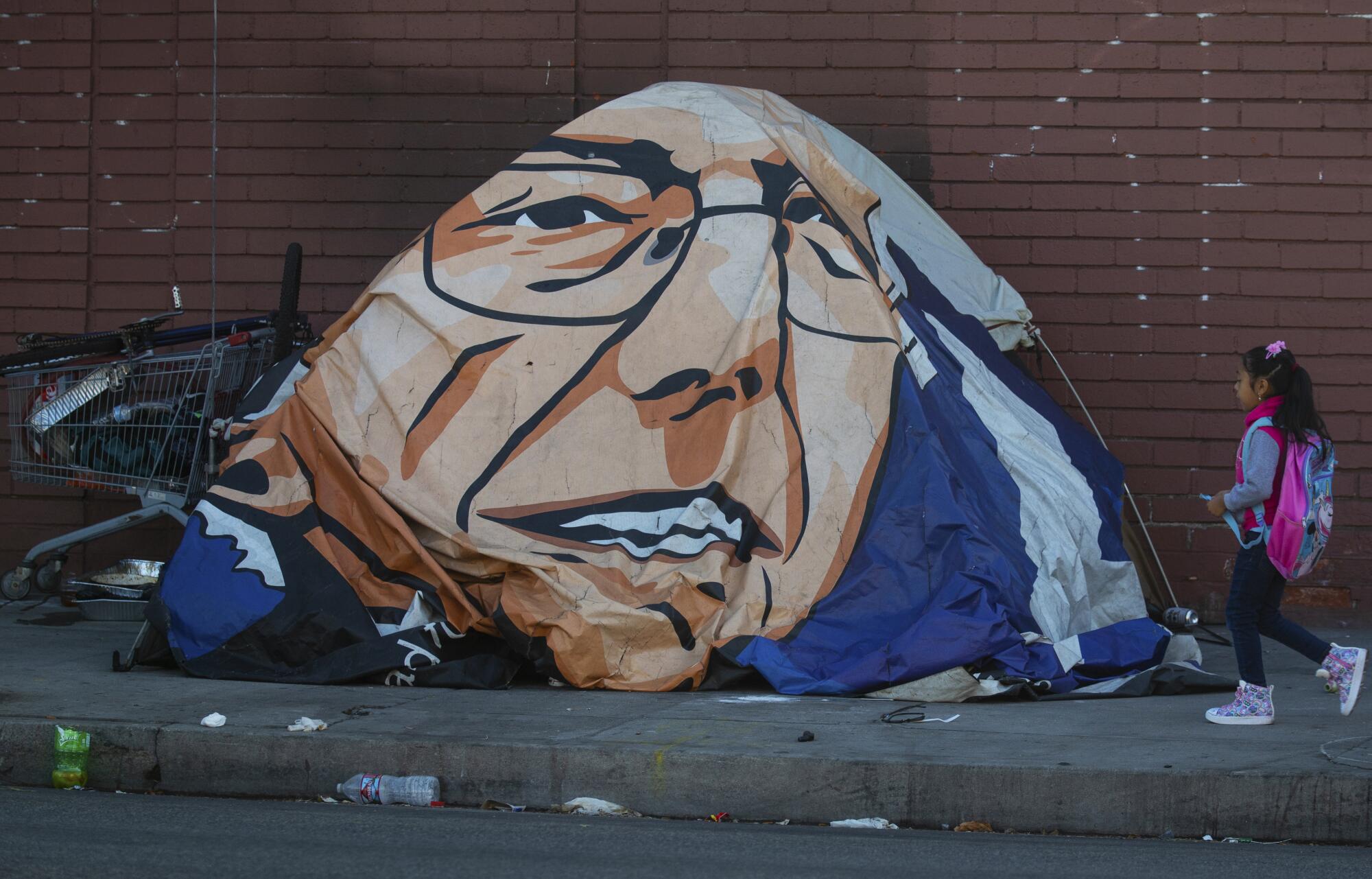
She wears a bright red T-shirt, red pants and has woven red yarn into her hair. Bam is back, also wearing red. They have an easy manner together and talk about getting married.
Heâs 11 years younger than she is and dreams of becoming a rapper. He has a few rhymes in his head.
My people, why are we not treated like we are equals?
Label us criminals âcause weâre out to sell drugs.
Reason is ⌠a better life for our kids
than our parents couldnât give
even if it is the same method that they didâŚ.
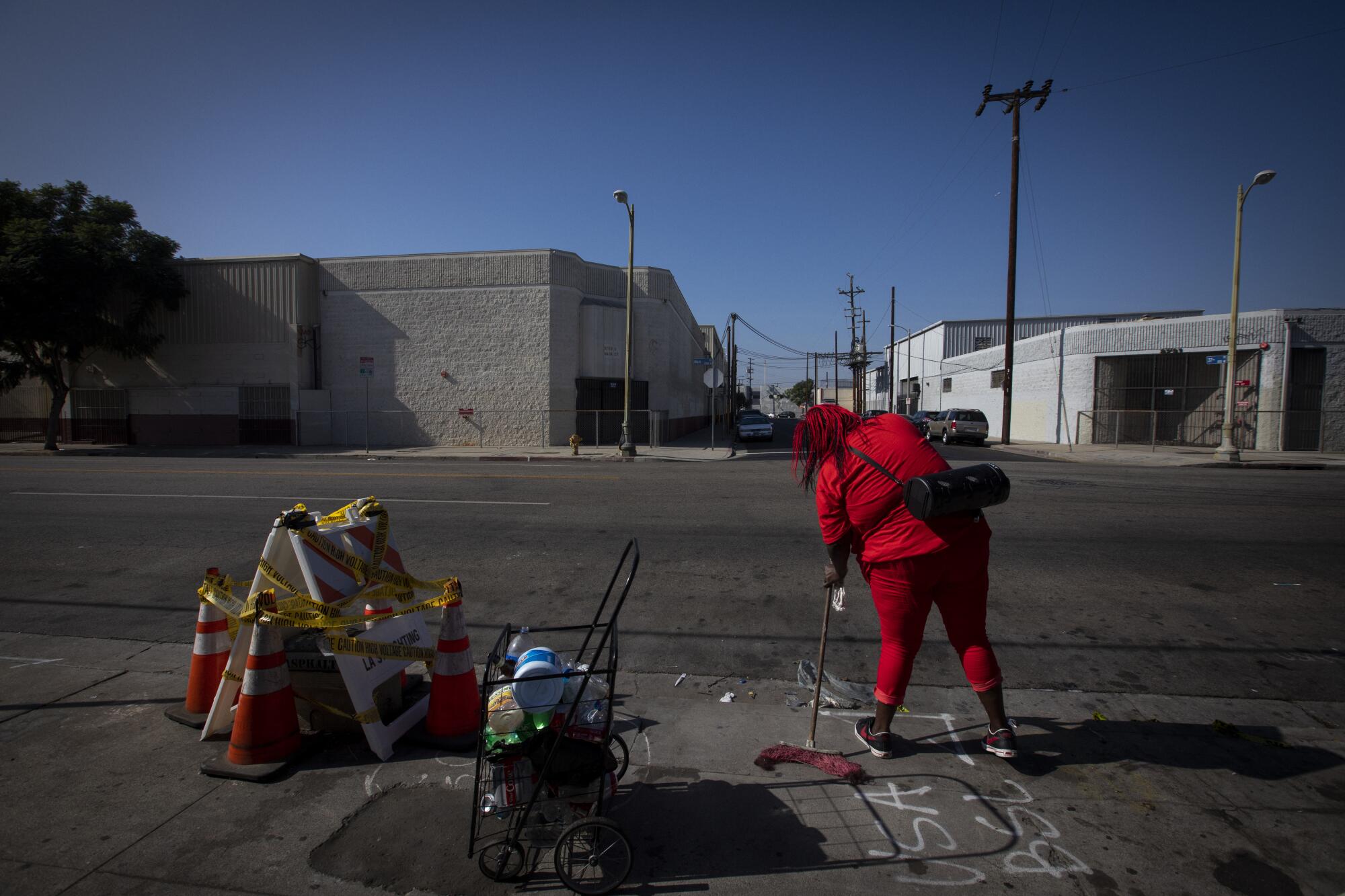
Broom in hand, Niecy tidies the sidewalk.
She sloshes the perimeter of her tent with water taken from a hose bib on a building just up the street. Bam is inside the tent sweeping.
Next door, JeâKwese hands Dion a cigarette.
His mother says losing his apartment was Godâs will. She told him that if he didnât mend his ways, God would take everything away from him.
He lives with that and the ache of missing his daughter.
âThere is no being comfortable out here,â he says, then adds quietly: âEvery time I talk to my daughter, I cry. It hurts.â
He complains that his case manager isnât available when he needs her. He says that he leaves messages, but sheâs slow to respond.
For her part, Stephanie Mimbs is trying to be patient.
When a lack of transportation keeps Dion from making it to an appointment, Mimbs gives him a bus pass. Still, they find it hard to meet.
âIâm sure when Dion realizes his housing is not going to drop in his lap, that he has a responsibility in this as well, he will start working toward his goal of being housed,â she writes in an email. âI will do my best to help him, however he must meet me halfway.â
::
At 4 p.m. on a day in late November, rain clouds carpet the sky and catch the setting sun in wind-tossed textures.
Robert Taylor stands amid his tarps and shopping carts, getting ready for what threatens to be a soggy night. But he seems unconcerned and smiles broadly.
âDid you see that rainbow?â he calls out.
Over on Main Street, Dion and JeâKwese have decorated their tarp and pallet with a big red Elmo doll, its googly eyes staring along the sidewalk. Dion calls out from inside that he is getting his hair done.
Carrying umbrellas in the dimming light, Niecy and Bam walk down Main Street to 39th. Her speaker flashes blue, green and red as she cues up some beats.
On Broadway Place, the green cross on the pot shop shines down on a full parking lot.
Niecy and Bam pass a cigarette back and forth and are soon joined by others.
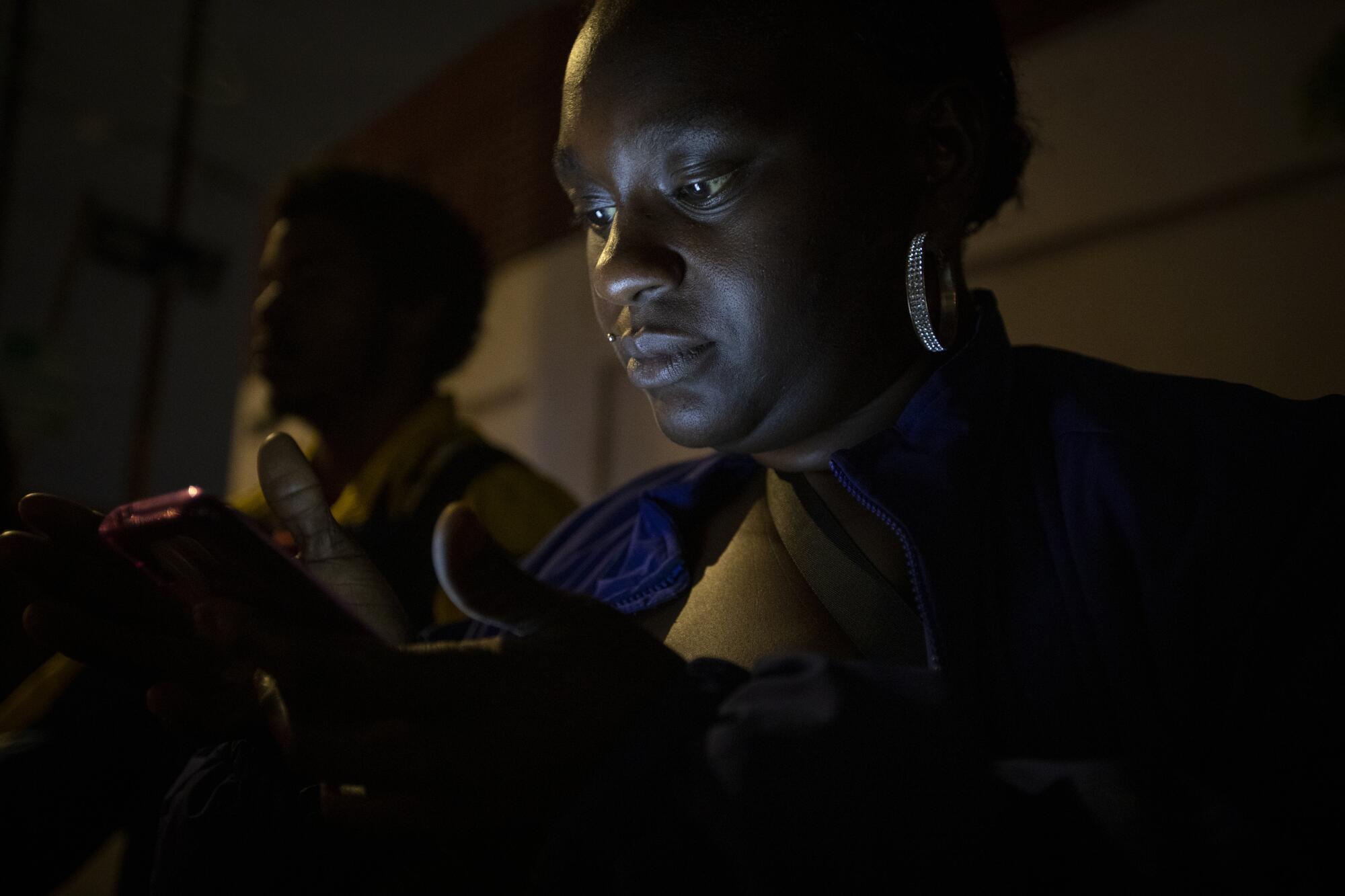
Niecy pulls out her phone. After reading an astrological site, she opens her photo app to share pictures from a reception after her grandmotherâs funeral. Ruby died in late October.
In one shot, Niecy stands with three of her children, all handsomely dressed, in her auntâs large home, which she said was in the Windsor Hills neighborhood of Los Angeles. Her daughter beams with a big smile for the camera.
Rain starts falling. Niecy and Bam open umbrellas.
They begin walking back to their tent and disappear into the night.
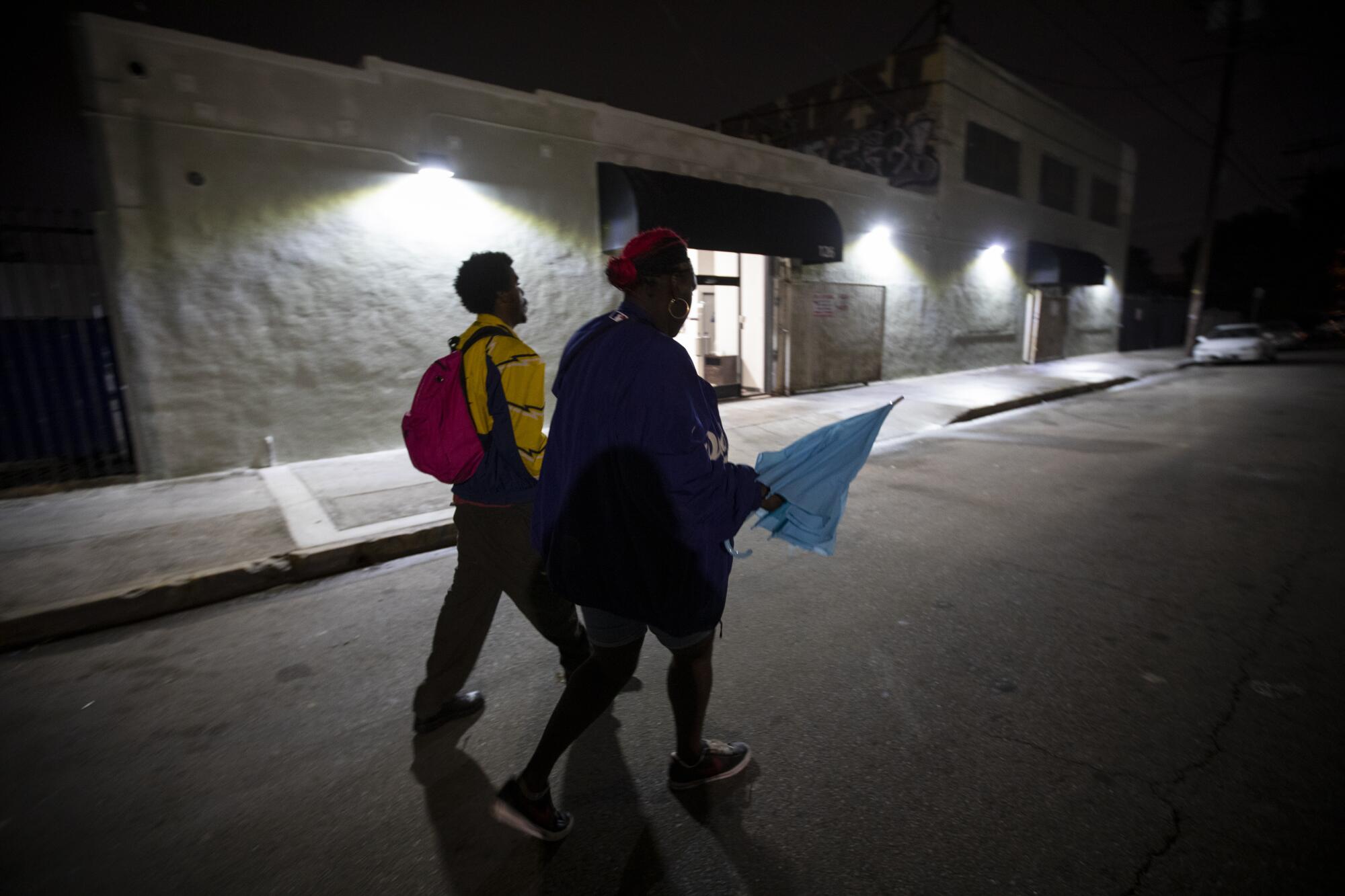
The Street Within: Read the entire series
More to Read
Sign up for Essential California
The most important California stories and recommendations in your inbox every morning.
You may occasionally receive promotional content from the Los Angeles Times.
